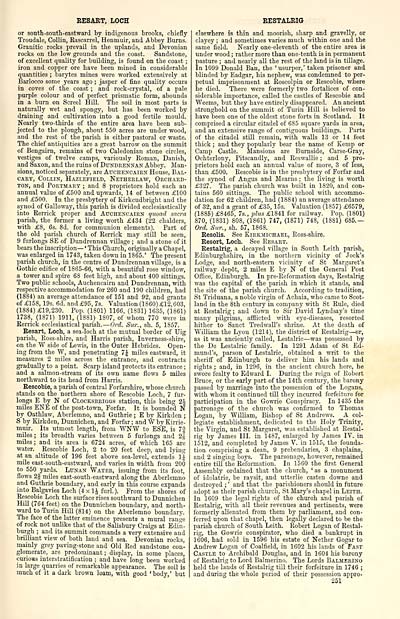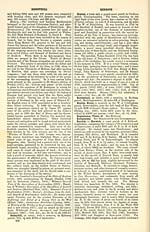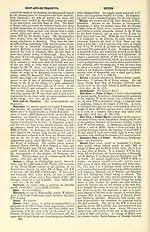Ordnance gazetteer of Scotland > Volume 6
(61) Page 251
Download files
Complete book:
Individual page:
Thumbnail gallery: Grid view | List view

RESART, LOCH
or south-south-eastward by indigenous brooks, chiefly
Troudale, Collin, Rascarrel, Henmuir, and Abbey Burns.
Granitic rocks prevail in the uplands, and Devonian
rocks on the low grounds and the coast. Sandstone,
of excellent quality for building, is found on the coast ;
iron and copper ore have been mined in considerable
quantities ; barytes mines were worked extensively at
Barlocco some years ago ; jasper of fine quality occurs
in coves of the coast ; and rock-crystal, of a pale
purple colour and of perfect prismatic form, abounds
in a burn on Screel Hill. The soil in most parts is
naturally wet and spongy, but has been worked by
draining and cultivation into a good fertile mould.
Nearly two-thirds of the entire area have been sub-
jected to the plough, about 550 acres are under wood,
and the rest of the parish is either pastoral or waste.
The chief antiquities are a great barrow on the summit
of Bengairn, remains of two Caledonian stone circles,
vestiges of twelve camps, variously Roman, Danish,
and Saxon, and the ruins of Dundrennan Abbey. Man-
sions, noticed separately, are Attchencairn House, Bal-
cary, Collin, Hazlefield, Netherlaw, Orchard-
ton, and Portmart ; and 8 proprietors hold each an
annual value of £500 and upwards, 14 of between £100
and £500. In the presbytery of Kirkcudbright and the
synod of Galloway, this parish is divided ecclesiastically
into Kerrick proper and Auchenoairn quoad sacra
parish, the former a living worth £434 (22 chalders,
with £8, 6s. 8d. for communion elements). Part of
the old parish church of Eerrick may still be seen,
9 furlongs SE of Dundrennan village ; and a stone of it
bears the inscription — ' This Church, originally a Chapel,
was enlarged in 1743, taken down in 1865.' The present
parish church, in the centre of Dundrennan village, is a
Gothic edifice of 1865-66, with a beautiful rose window,
a tower and spire 68 feet high, and about 400 sittings.
Two public schools, Auchencairn and Dundrennan, with
respective accommodation for 260 and 190 children, had
(1884) an average attendance of 151 and 92, and grants
of £158, 19s. 6d. and £95, 7s. Valuation (1860) £12, 603,
(1884) £19,230. Pop. (1801) 1166, (1831) 1635, (1861)
1738, (1871) 1911, (1881) 1807, of whom 770 were in
Rerriek ecclesiastical parish. — Ord. Sur., sh. 5, 1857.
Resart, Loch, a sea-loch at the mutual border of Uig
parish, Ross-shire, and Harris parish, Inverness-shire,
on the W side of Lewis, in the Outer Hebrides. Open-
ing from the W, and penetrating "t\ miles eastward, it
measures 2 miles across the entrance, and contracts
gradually to a point. Scarp island protects its entrance ;
and a salmon -stream of its own name flows 5 miles
northward to its head from Harris.
Rescobie, a parish of central Forfarshire, whose church
stands on the northern shore of Rescobie Loch, 7 fur-
longs E by N of Clocksbrigqs station, this being 2i
miles ENE of the post-town, Forfar. It is bounded N
by Oathlaw, Aberlemno, and Guthrie ; E by Eirkden ;
S by Kirkden, Dunnichen, and Forfar; and W by Kirrie-
muir. Its utmost length, from WNW to ESE, is 7|
miles ; its breadth varies between 5 furlongs and 2g
miles ; and its area is 6724 acres, of which 165 are
water. Rescobie Loch, 2 to 20 feet deep, and lying
at an altitude of 196 feet above sea-level, extends l|
mile east-south-eastward, and varies in width from 200
to 550 yards. Lunan Water, issuing from its foot,
flows 2| miles east-south-eastward along the Aberlemno
and Guthrie boundary, and early in this course expands
into Balgavies Loch (4 x 1 J furl. ). From the shores of
Rescobie Loch the surface rises southward to Dunnichen
Hill (764 feet) on the Dunnichen boundary, and north-
ward to Turin Hill (814) on the Aberlemno boundary.
The face of the latter eminence presents a mural range
of rock not unlike that of the Salisbury Craigs at Edin-
burgh ; and its summit commands a very extensive and
brilliant view of both land and sea. Devonian rocks,
mainly grey paving-stone and Old Red sandstone con-
glomerate, are predominant; display, in some places,
curioas interstratification ; and have long been worked
in large quarries of remarkable appearance. The soil is
much of it a dark brown loam, with good 'body,' but
RESTALRIG
elsewhere is thin and moorish, sharp and gravelly, or
clayey ; and sometimes varies much within one and the
same field. Nearly one-eleventh of the entire area is
under wood ; rather more than one-tenth is in permanent
pasture ; and nearly all the rest of the land is in tillage.
In 1099 Donald Ban, the 'usurper,' taken prisoner and
blinded by Eadgar, his nephew, was condemned to per-
petual imprisonment at Roscolpin or Rescobie, where
he died. There were formerly two fortalices of con-
siderable importance, called the castles of Rescobie and
Weems, but they have entirely disappeared. An ancient
stronghold on the summit of Turin Hill is believed to
have been one of the oldest stone forts in Scotland. It
comprised a circular citadel of 685 square yards in area,
and an extensive range of contiguous buildings. Parts
of the citadel still remain, with walls 13 or 14 feet
thick ; and they popularly bear the name of Kemp or
Camp Castle. Mansions are Burnside, Carse-Gray,
Ochterlony, Pitscandly, and Reswallie ; and 5 pro-
prietors hold each an annual value of more, 3 of less,
than £500. Rescobie is in the presbytery of Forfar and
the synod of Angus and Mearns ; the living is worth
£327. The parish church was built in 1820, and con-
tains 560 sittings. The public school with accommo-
dation for 62 children, had (1884) an average attendance
of 32, and a grant of £35, 15s. Valuation (1857) £6579,
(1885) £8465, 7s., plus £1841 for railway. Pop. (1801)
870, (1831) 808, (1861) 747, (1871) 748, (1881) 685.—
Ord. Sur., sh. 57, 1868.
Resolis. See Kirkmichael, Ross-shire.
Resort, Loch. See Resart.
Restalrig, a decayed village in South Leith parish,
Edinburghshire, in the northern vicinity of Jock's
Lodge, and north-eastern vicinity of St Margaret's
railway depdt, 2 miles E by N of the General Post
Office, Edinburgh. In pre-Reformation days, Restalrig
was the capital of the parish in which it stands, and
the site of the parish church. According to tradition,
St Triduana, a noble virgin of Achaia, who came to Scot-
land in the 8th century in company with St Rule, died
at Restalrig ; and down to Sir David Lyndsay's time
many pilgrims, afflicted with eye-diseases, resorted
hither to Sanct Tredwall's shrine. At the death of
William the Lyon (1214), the district of Restalrig — or,
as it was anciently called, Lestalric — was possessed by
the De Lestalric family. In 1291 Adam of St Ed-
mund's, parson of Lestalric, obtained a writ to the
sheriff of Edinburgh to deliver him his lands and
rights ; and, in 1296, in the ancient church here, he
swore fealty to Edward I. During the reign of Robert
Bruce, or the early part of the 14th eentmy, the barony
passed by marriage into the possession of the Logans,
with whom it continued till they incurred forfeiture for
participation in the Gowrie Conspiracy. In 1435 the
patronage of the church was confirmed to Thomas
Logan, by William, Bishop of St Andrews. A col-
legiate establishment, dedicated to the Holy Trinity,
the Virgin, and St Margaret, was established at Restal-
rig by James III. in 1487, enlarged by James IV. in
1512, and completed by James V. in 1515, the founda-
tion comprising a dean, 9 prebendaries, 3 chaplains,
and 2 singing boys. The parsonage, however, remained
entire till the Reformation. In 1560 the first General
Assembly ordained that the church, ' as a monument
of idolatrie, be raysit, and utterlie casten downe and
destroyed ; ' and that the parishioners should in future
adopt as their parish church, St Mary's chapel in Leith.
In 1609 the legal rights of the church and parish of
Restalrig, with all their revenues and pertinents, were
formerly alienated from them by parliament, and con-
ferred upon that chapel, then legally declared to be the
parish church of South Leith. Robert Logan of Restal-
rig, the Gowrie conspirator, who died a bankrupt in
1606, had sold in 1596 his estate of Nether Gogar to
Andrew Logan of Coalfield, in 1602 his lands of Fast
Castle to Archibald Douglas, and in 1604 his barony
of Restalrig to Lord Balmerino. The Lords Balmerino
held the lands of Restalrig till their forfeiture in 1746 ;
and during the whole period of their possession appro-
251
or south-south-eastward by indigenous brooks, chiefly
Troudale, Collin, Rascarrel, Henmuir, and Abbey Burns.
Granitic rocks prevail in the uplands, and Devonian
rocks on the low grounds and the coast. Sandstone,
of excellent quality for building, is found on the coast ;
iron and copper ore have been mined in considerable
quantities ; barytes mines were worked extensively at
Barlocco some years ago ; jasper of fine quality occurs
in coves of the coast ; and rock-crystal, of a pale
purple colour and of perfect prismatic form, abounds
in a burn on Screel Hill. The soil in most parts is
naturally wet and spongy, but has been worked by
draining and cultivation into a good fertile mould.
Nearly two-thirds of the entire area have been sub-
jected to the plough, about 550 acres are under wood,
and the rest of the parish is either pastoral or waste.
The chief antiquities are a great barrow on the summit
of Bengairn, remains of two Caledonian stone circles,
vestiges of twelve camps, variously Roman, Danish,
and Saxon, and the ruins of Dundrennan Abbey. Man-
sions, noticed separately, are Attchencairn House, Bal-
cary, Collin, Hazlefield, Netherlaw, Orchard-
ton, and Portmart ; and 8 proprietors hold each an
annual value of £500 and upwards, 14 of between £100
and £500. In the presbytery of Kirkcudbright and the
synod of Galloway, this parish is divided ecclesiastically
into Kerrick proper and Auchenoairn quoad sacra
parish, the former a living worth £434 (22 chalders,
with £8, 6s. 8d. for communion elements). Part of
the old parish church of Eerrick may still be seen,
9 furlongs SE of Dundrennan village ; and a stone of it
bears the inscription — ' This Church, originally a Chapel,
was enlarged in 1743, taken down in 1865.' The present
parish church, in the centre of Dundrennan village, is a
Gothic edifice of 1865-66, with a beautiful rose window,
a tower and spire 68 feet high, and about 400 sittings.
Two public schools, Auchencairn and Dundrennan, with
respective accommodation for 260 and 190 children, had
(1884) an average attendance of 151 and 92, and grants
of £158, 19s. 6d. and £95, 7s. Valuation (1860) £12, 603,
(1884) £19,230. Pop. (1801) 1166, (1831) 1635, (1861)
1738, (1871) 1911, (1881) 1807, of whom 770 were in
Rerriek ecclesiastical parish. — Ord. Sur., sh. 5, 1857.
Resart, Loch, a sea-loch at the mutual border of Uig
parish, Ross-shire, and Harris parish, Inverness-shire,
on the W side of Lewis, in the Outer Hebrides. Open-
ing from the W, and penetrating "t\ miles eastward, it
measures 2 miles across the entrance, and contracts
gradually to a point. Scarp island protects its entrance ;
and a salmon -stream of its own name flows 5 miles
northward to its head from Harris.
Rescobie, a parish of central Forfarshire, whose church
stands on the northern shore of Rescobie Loch, 7 fur-
longs E by N of Clocksbrigqs station, this being 2i
miles ENE of the post-town, Forfar. It is bounded N
by Oathlaw, Aberlemno, and Guthrie ; E by Eirkden ;
S by Kirkden, Dunnichen, and Forfar; and W by Kirrie-
muir. Its utmost length, from WNW to ESE, is 7|
miles ; its breadth varies between 5 furlongs and 2g
miles ; and its area is 6724 acres, of which 165 are
water. Rescobie Loch, 2 to 20 feet deep, and lying
at an altitude of 196 feet above sea-level, extends l|
mile east-south-eastward, and varies in width from 200
to 550 yards. Lunan Water, issuing from its foot,
flows 2| miles east-south-eastward along the Aberlemno
and Guthrie boundary, and early in this course expands
into Balgavies Loch (4 x 1 J furl. ). From the shores of
Rescobie Loch the surface rises southward to Dunnichen
Hill (764 feet) on the Dunnichen boundary, and north-
ward to Turin Hill (814) on the Aberlemno boundary.
The face of the latter eminence presents a mural range
of rock not unlike that of the Salisbury Craigs at Edin-
burgh ; and its summit commands a very extensive and
brilliant view of both land and sea. Devonian rocks,
mainly grey paving-stone and Old Red sandstone con-
glomerate, are predominant; display, in some places,
curioas interstratification ; and have long been worked
in large quarries of remarkable appearance. The soil is
much of it a dark brown loam, with good 'body,' but
RESTALRIG
elsewhere is thin and moorish, sharp and gravelly, or
clayey ; and sometimes varies much within one and the
same field. Nearly one-eleventh of the entire area is
under wood ; rather more than one-tenth is in permanent
pasture ; and nearly all the rest of the land is in tillage.
In 1099 Donald Ban, the 'usurper,' taken prisoner and
blinded by Eadgar, his nephew, was condemned to per-
petual imprisonment at Roscolpin or Rescobie, where
he died. There were formerly two fortalices of con-
siderable importance, called the castles of Rescobie and
Weems, but they have entirely disappeared. An ancient
stronghold on the summit of Turin Hill is believed to
have been one of the oldest stone forts in Scotland. It
comprised a circular citadel of 685 square yards in area,
and an extensive range of contiguous buildings. Parts
of the citadel still remain, with walls 13 or 14 feet
thick ; and they popularly bear the name of Kemp or
Camp Castle. Mansions are Burnside, Carse-Gray,
Ochterlony, Pitscandly, and Reswallie ; and 5 pro-
prietors hold each an annual value of more, 3 of less,
than £500. Rescobie is in the presbytery of Forfar and
the synod of Angus and Mearns ; the living is worth
£327. The parish church was built in 1820, and con-
tains 560 sittings. The public school with accommo-
dation for 62 children, had (1884) an average attendance
of 32, and a grant of £35, 15s. Valuation (1857) £6579,
(1885) £8465, 7s., plus £1841 for railway. Pop. (1801)
870, (1831) 808, (1861) 747, (1871) 748, (1881) 685.—
Ord. Sur., sh. 57, 1868.
Resolis. See Kirkmichael, Ross-shire.
Resort, Loch. See Resart.
Restalrig, a decayed village in South Leith parish,
Edinburghshire, in the northern vicinity of Jock's
Lodge, and north-eastern vicinity of St Margaret's
railway depdt, 2 miles E by N of the General Post
Office, Edinburgh. In pre-Reformation days, Restalrig
was the capital of the parish in which it stands, and
the site of the parish church. According to tradition,
St Triduana, a noble virgin of Achaia, who came to Scot-
land in the 8th century in company with St Rule, died
at Restalrig ; and down to Sir David Lyndsay's time
many pilgrims, afflicted with eye-diseases, resorted
hither to Sanct Tredwall's shrine. At the death of
William the Lyon (1214), the district of Restalrig — or,
as it was anciently called, Lestalric — was possessed by
the De Lestalric family. In 1291 Adam of St Ed-
mund's, parson of Lestalric, obtained a writ to the
sheriff of Edinburgh to deliver him his lands and
rights ; and, in 1296, in the ancient church here, he
swore fealty to Edward I. During the reign of Robert
Bruce, or the early part of the 14th eentmy, the barony
passed by marriage into the possession of the Logans,
with whom it continued till they incurred forfeiture for
participation in the Gowrie Conspiracy. In 1435 the
patronage of the church was confirmed to Thomas
Logan, by William, Bishop of St Andrews. A col-
legiate establishment, dedicated to the Holy Trinity,
the Virgin, and St Margaret, was established at Restal-
rig by James III. in 1487, enlarged by James IV. in
1512, and completed by James V. in 1515, the founda-
tion comprising a dean, 9 prebendaries, 3 chaplains,
and 2 singing boys. The parsonage, however, remained
entire till the Reformation. In 1560 the first General
Assembly ordained that the church, ' as a monument
of idolatrie, be raysit, and utterlie casten downe and
destroyed ; ' and that the parishioners should in future
adopt as their parish church, St Mary's chapel in Leith.
In 1609 the legal rights of the church and parish of
Restalrig, with all their revenues and pertinents, were
formerly alienated from them by parliament, and con-
ferred upon that chapel, then legally declared to be the
parish church of South Leith. Robert Logan of Restal-
rig, the Gowrie conspirator, who died a bankrupt in
1606, had sold in 1596 his estate of Nether Gogar to
Andrew Logan of Coalfield, in 1602 his lands of Fast
Castle to Archibald Douglas, and in 1604 his barony
of Restalrig to Lord Balmerino. The Lords Balmerino
held the lands of Restalrig till their forfeiture in 1746 ;
and during the whole period of their possession appro-
251
Set display mode to: Large image | Transcription
Images and transcriptions on this page, including medium image downloads, may be used under the Creative Commons Attribution 4.0 International Licence unless otherwise stated. ![]()
| Gazetteers of Scotland, 1803-1901 > Ordnance gazetteer of Scotland > Volume 6 > (61) Page 251 |
|---|
| Permanent URL | https://digital.nls.uk/97388334 |
|---|
| Attribution and copyright: |
|
|---|---|

